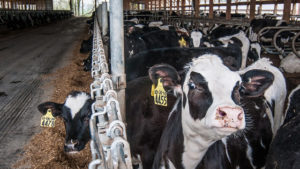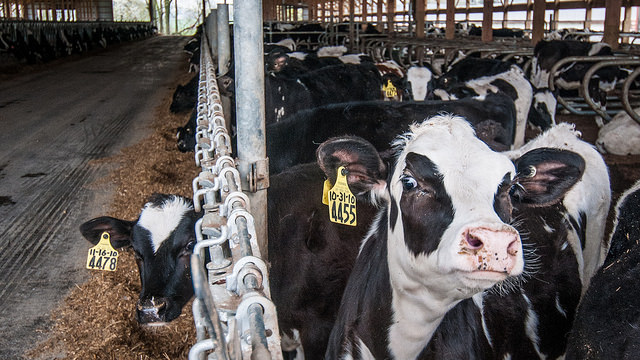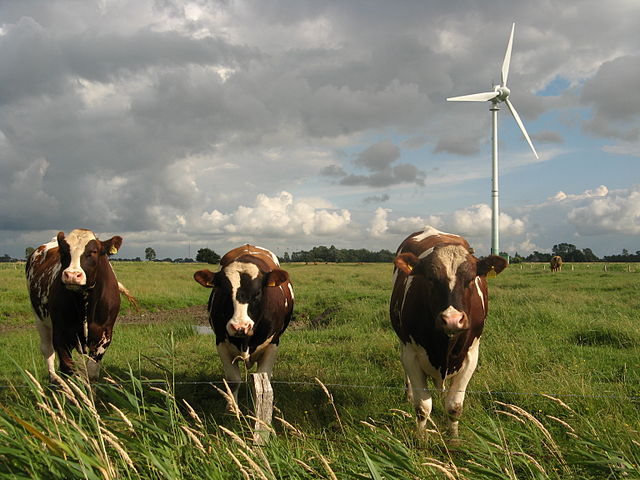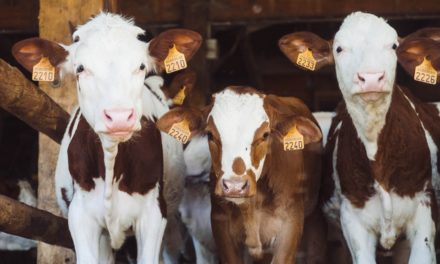There is scientific consensus that greenhouse gases are one of the major causes of global warming, and countries across the world, including the United States, are working to lower the levels of greenhouse gases. In order to meet emission reduction goals established by regulating agencies, it is necessary to establish new laws and use technology in new ways for effectively mitigating as much of these gases as possible. Because of this, lawmakers across the United States are attempting to decrease greenhouse gas emissions using some very creative techniques.
On September 19, 2016, California Governor Jerry Brown signed Senate Bill No. 1383 into law, establishing new initiatives for reducing the amount of short-lived climate pollutants (SLCPs) being released into the atmosphere. Governor Jerry Brown recognized that SLCPs are dangerous chemicals that are detrimental to public health and that they contribute to global warming.

Feeding time in the free stall heifer barns at Brubaker Farms, which is both a diary and green energy producer in Mount Joy, PA on March 19, 2011. USDA Photo by Lance Cheung.
According to the California Environmental Protection Agency, short-lived climate pollutants are gases that remain in the atmosphere for a very short amount of time, as opposed to more long-term gases like carbon dioxide. However, SLCPs are significantly more potent, sometimes even thousands of times stronger than carbon dioxide. The most commonly known SLCPs are black carbon, methane, and fluorinated gases, including hydrofluorocarbons (HFCs). California’s bill calls for a reduction in methane and HFC levels of 40 percent below 2013 levels by 2030 and carbon black levels of 50 percent below 2013 levels by 2030.
One of the primary ways that Senate Bill No. 1383 will reduce SLCPs is by decreasing methane emissions emitted by livestock, specifically cows. The average dairy cow releases between 30 and 50 gallons of methane into the atmosphere each day through its flatulence and manure. With thousands of cows in California and over one billion across the globe, livestock is the largest producer of methane gas in the U.S. and contributes over 28 percent of the total emissions worldwide.
How is this going to be accomplished?
Under a California cap and trade plan, farmers would receive aid from a fund of $50 million raised by polluters for assistance in purchasing machines, called methane digesters, which use methane to generate electricity. Sustainable Conservation describes the technical details about this process. Put simply, manure is collected in the digester where the resulting methane can be trapped and transformed into biogas. The biogas is combusted to generate electricity or further refined to create biomethane, which is similar to natural gas and can be used in pipelines. Farmers can then sell their generated energy to electric companies. This process also yields products like fertilizer which farmers can also use or sell in the market.
This methane conversion plan is one of the methods that California is using to decrease it SLCP emissions. The incentive plan should be an effective avenue to reduce emissions, especially methane, simply due to the large volume produced by livestock. Because this is a renewable source of energy, methane conversion could potentially reduce California’s reliance on non-renewable resources to generate power. Additionally, methane conversion holds the manure in the digester instead of a lagoon, significantly reducing the likelihood of a contamination incident.
Could there be unforeseen negative effects?
Under the cap and trade incentive plan, it could become advantageous for farmers to sell more energy, increasing their capacity to generate their desired amount of power. If the benefits from the program significantly outweigh the costs, farms may increase their amount of livestock and increase their number methane digesters, allowing them to produce more power. This could possibly lead to a surplus of beef and dairy products, especially with an increasing trend toward vegetarianism and veganism in the U.S.
On the other hand, however, the profitability of selling energy produced by methane conversion is tied to the current market prices for energy. Currently, natural gas prices are low, and many farmers participating in waste-to-energy production are shutting down their operations because it just doesn’t pay enough. Low profits coupled with expensive maintenance fees have deterred start-up in this sector. The Wall Street Journal outlines this trend, which is becoming more prevalent. With cheap natural gas and more-desirable wind and solar power, farmers can no longer profit enough to continue operating as a waste-to-energy provider.
Do you think this will be an effective method for reducing greenhouse gases in California? Let us know in the comments.






Recent Comments